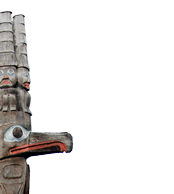 |
|||||||||
 |
|||||||||
 |
|||||||||

Songhees |
||
|---|---|---|
Traditional Coast Salish canoes were distinctive. These oceangoing canoes had a straight keel, a low pointed bow with a mouth-like slot at the end, and a stern with a gradual upward taper. Some traditional fishing canoes continued to be used until the early 20th century but the Nuu-chah-nulth style of canoe dominated the southern coast canoe market from the 1860s onward. In the late 19th century, canoe racing and commercial fishing were undertaken using canoes of the Nuu-chah-nulth style. The popular canoe races of the early 20th century featured hybrid English/Nuu-chah-nulth racing canoes. Commercial fishing was increasingly done using plank-hulled, European-style Columbia River fishing boats. |
||
 |
The most common style of canoe used by Coast Salish peoples had a low pointed bow with a mouth-like slot and the straight angled stern, as illustrated by this model. RBCM: 11179 |
|
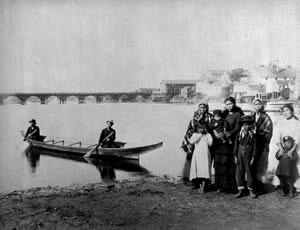 |
Songhees families with a northern-style canoe at the head of James Bay in 1875. The area that is now Thunderbird Park is at the water’s edge just to the left of where this photograph was taken. BC Archives: I-30804 |
|
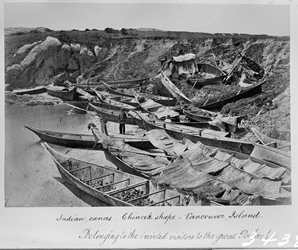 |
Canoes belonging to visitors attending a potlatch on the Old Songhees Reserve in 1869. Three canoes in the Coast Salish style can be seen drawn up on the bank next to a small, temporary house made of Tule mats. RBCM: PN 6446 |
|
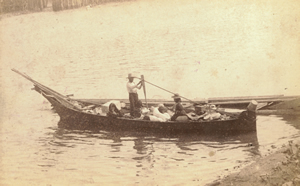 |
A family in Victoria harbour departs for a trip with their belongings in a Nuu-chah-nulth style canoe. RBCM: PN6839 |
|
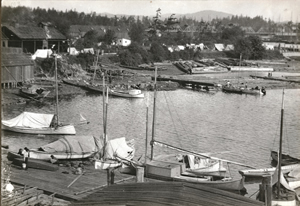 |
In the early 1900s, many First Nations people began to make the transition from traditional dugout canoes to Columbia River fishing boats made of planks and rigged with sails. This photograph was taken in the Hope Point area of the Old Songhees Reserve. RBCM: PN8769 |
|
For many years, First Nations canoe racing was an important event on the Gorge waterway, an inland extension of Victoria’s main harbour. During the gold rush of 1858, American visitors celebrating Independence Day initiated canoe regattas. (The local British, fearing an American takeover of the colony, forbade these activities and encouraged their replacement by celebrations focusing on Queen Victoria's birthday on May 24th instead.) Over time First Nations canoe racing became part of the larger Gorge regatta. Hundreds of people brought boats up the Gorge for festivities in the area below the reversing falls at the Tillicum Road Bridge. Here, the Navy strung colourful banners across the water. Local dignitaries handed out prizes at boat races held among the First Nations and Chinese communities, as well as among navy personnel and local clubs. The featured event was the race of the 40-foot (12.19m) ‘war canoes’. In the 1860s and 1870s, separate races were held for ‘Southern Indians’ (Salish-speaking) and ‘Northern Indians’ (e.g. Haida, Heiltsuk, Nuxalk and Kwakwaka’wakw). In the 1890s, it was mostly southern peoples who were involved in the races. The canoe entries for 1895 included the local Esquimalt, Songhees and Saanich Nations, various Cowichan and Chemainus area groups from Vancouver Island, and the Snohomish and Lummi from Washington State. The canoe races started near the Gorge waterfalls and moved down the Gorge, around Halkett Island in upper Victoria harbour, and back again. (In 1876, a Songhees canoe won the 3.2 km race with a time of 15 minutes.) By the early 1900s, some canoe races started in downtown Victoria. The racing ‘war canoes’ had given way to specially designed long, narrow craft that combined characteristics of English racing canoes and Nuu-chah-nulth canoes. The Gorge regatta was scaled down after the start of World War II and was only held on special occasions after 1948. But, beginning in the 1920s, local First Nations organized most of their own races at other locations. Today, canoe racing continues to be a thriving sport among the Lukwungen and other Coast Salish First Nations. |
||
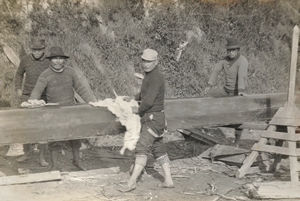 |
Visitors from Chemainus polish their canoe in preparation for a First Nations canoe race in the early 1900s. From left to right are Freddie Joe, Jack Norris, David Jack and Louie Norris. RBCM: PN8832 |
|
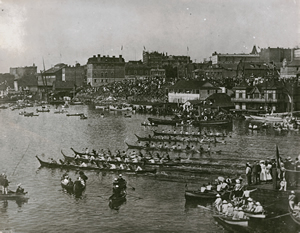 |
First Nations people in modern-style racing canoes compete in Victoria’s inner harbour in 1904. The event was part of the annual May 24th Queen’s Birthday celebrations. BC Archives: A-7202 |
|
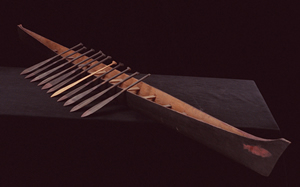 |
A model of a Coast Salish-style racing canoe from the first half of the 20th century. This type of canoe was specially designed for racing and continues to be used today. RBCM: 10520 a-l |
|
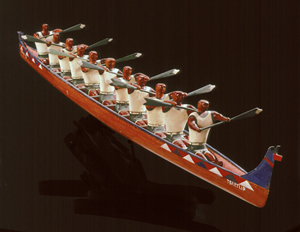 |
This model of a racing canoe was made by Thomas Paul of the Tsartlip First Nation in the mid-20th century. The Tsartlip, from the Saanich Peninsula near Victoria, would have participated in the Gorge regattas. RBCM: 16668 a-l |
|
Canoe races in Victoria harbour, historical (ca 1910) and modern (1994). First Peoples Festival, Victoria Native Friendship Centre & Native Participation Committee, Commonwealth Games, 1994. RBCM GNWC-V-036. |
||
Use the controller on the left to play video clip |
||
| Back to Songhees |
